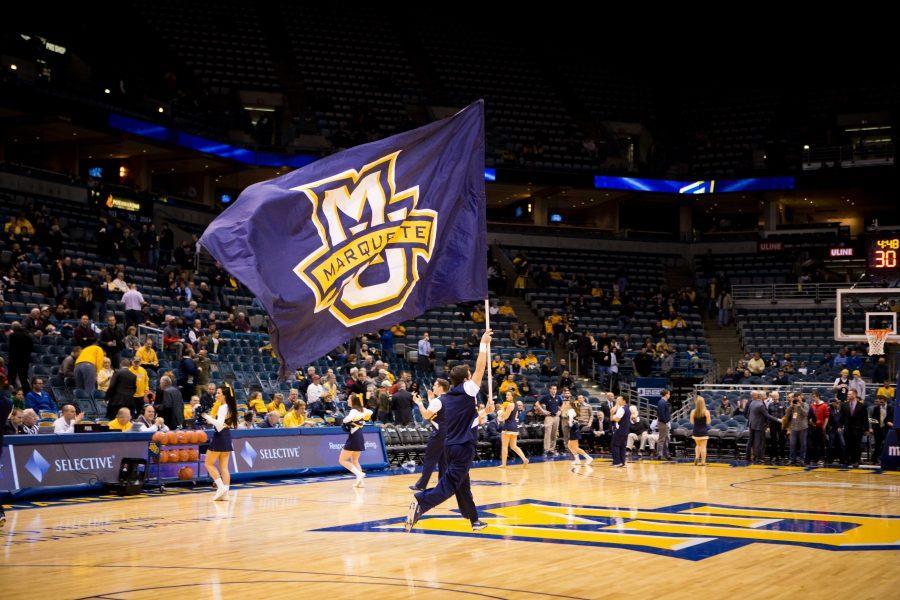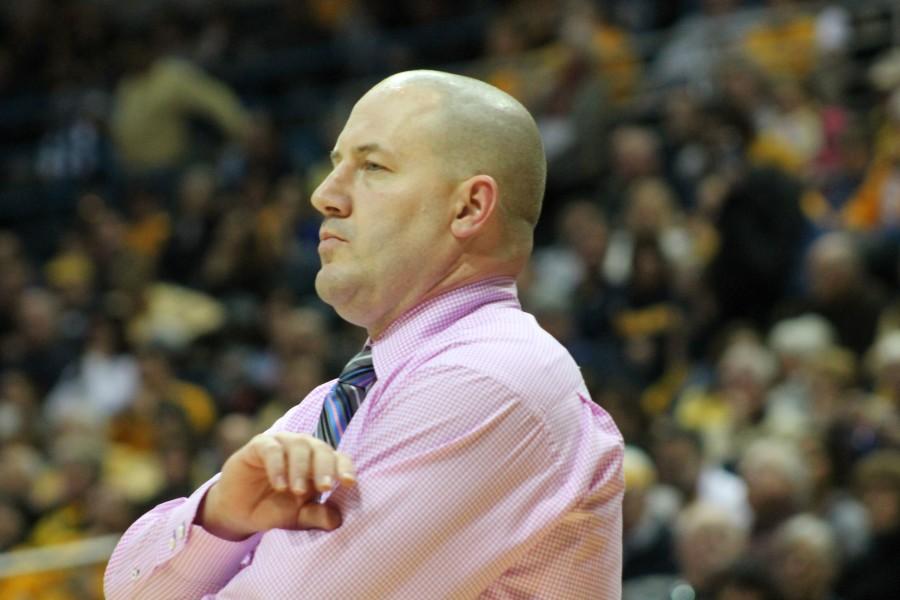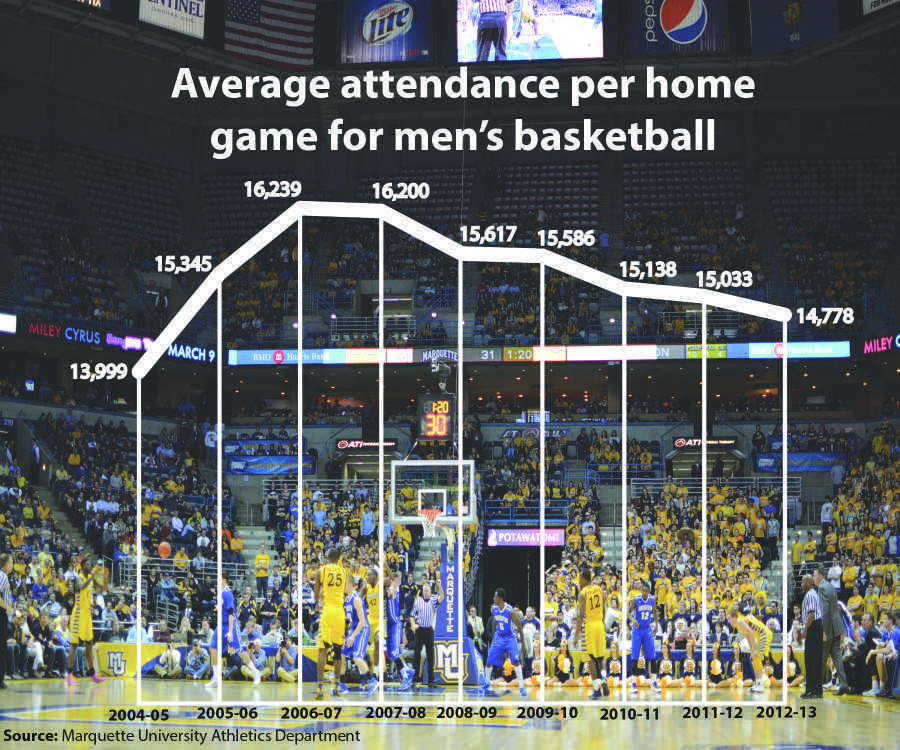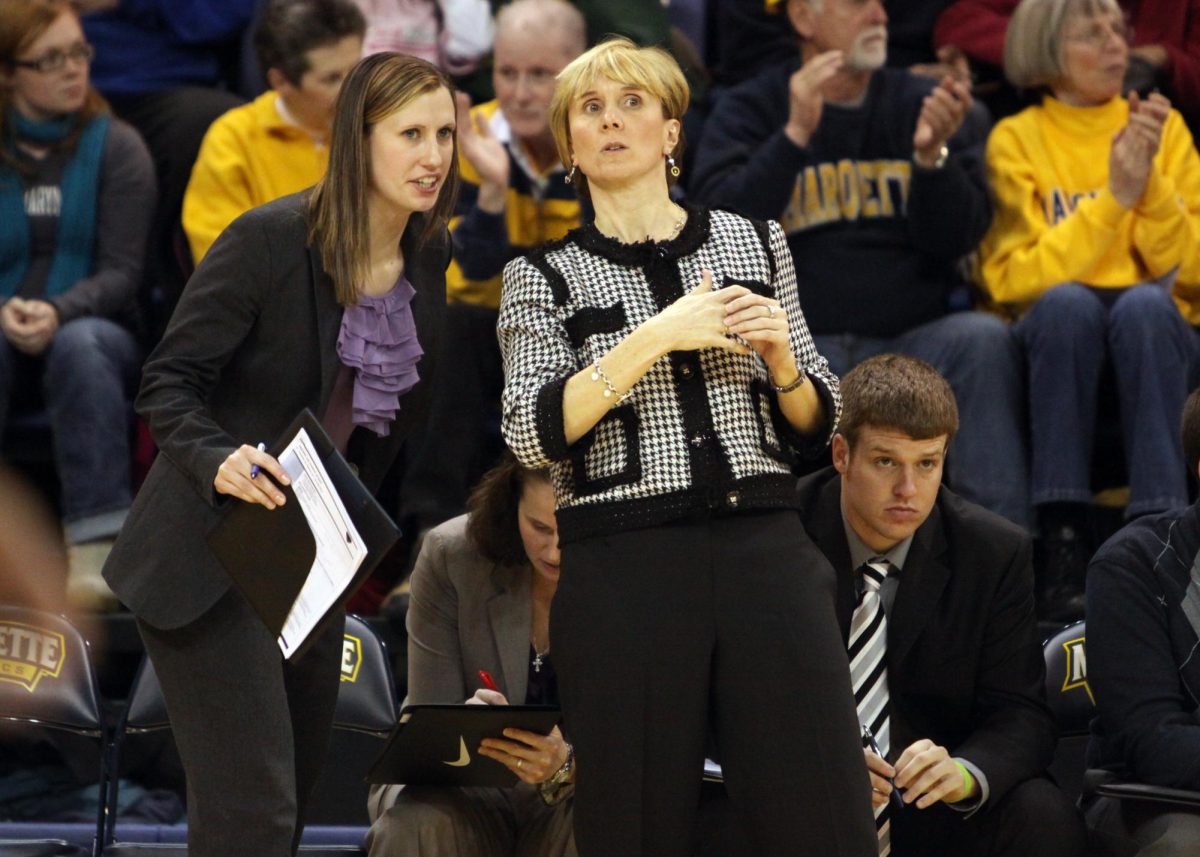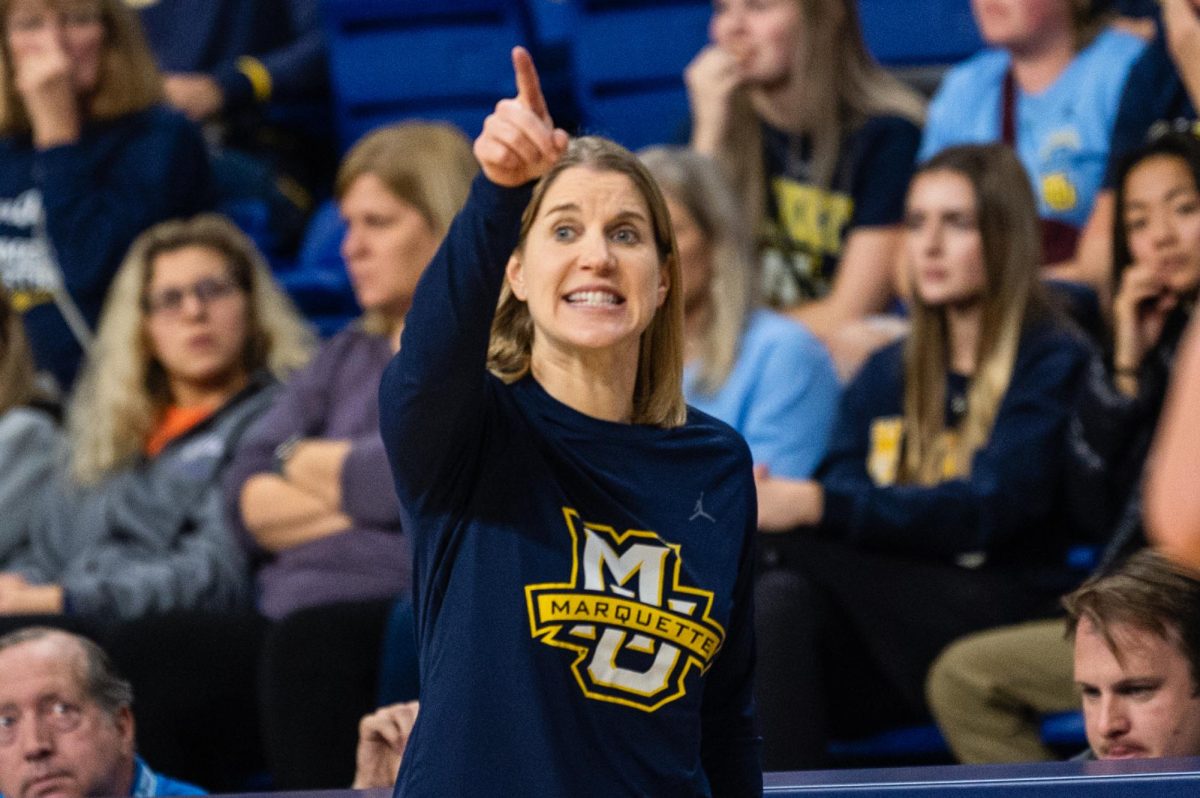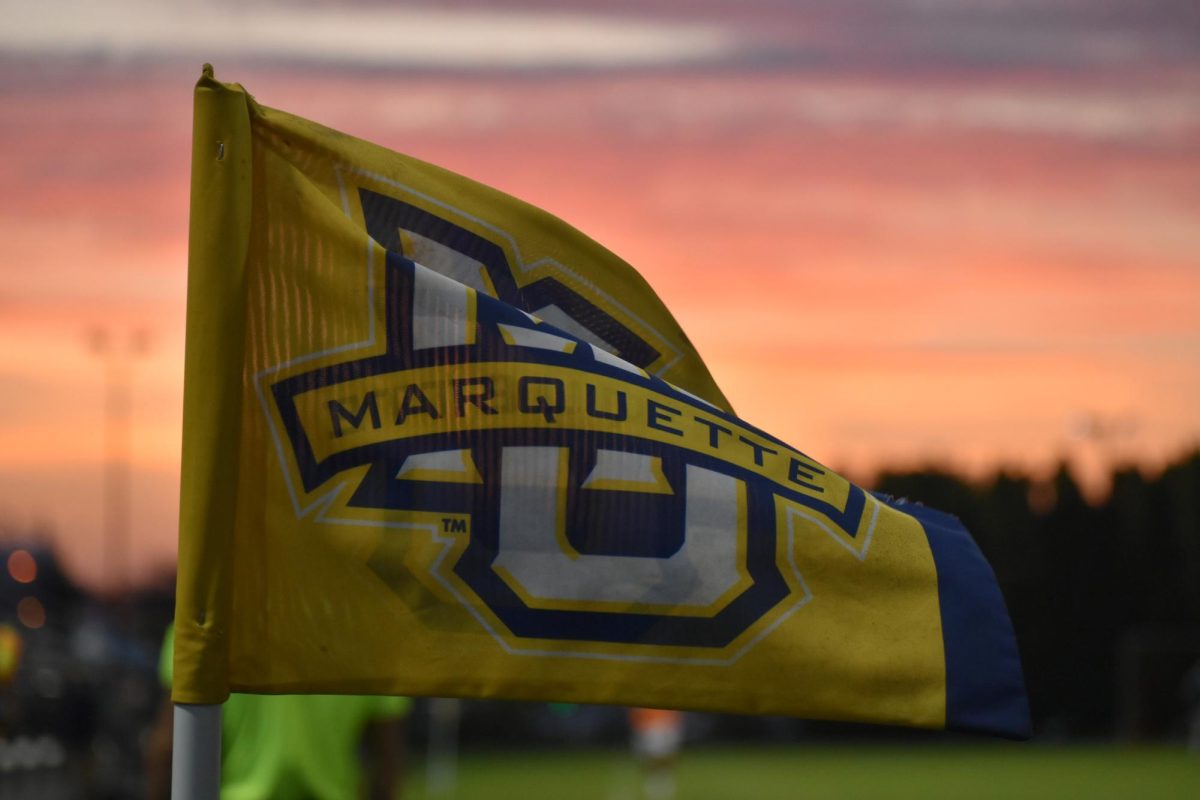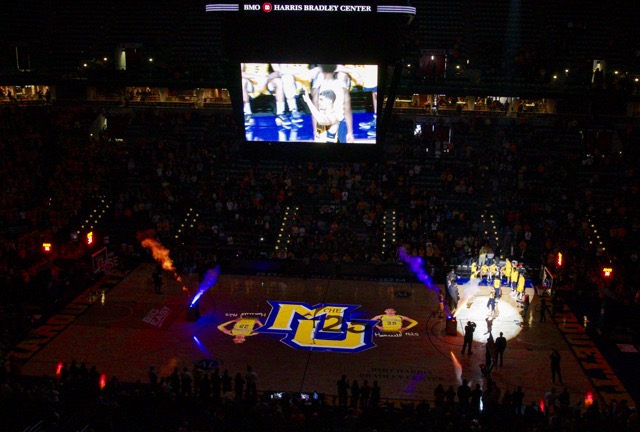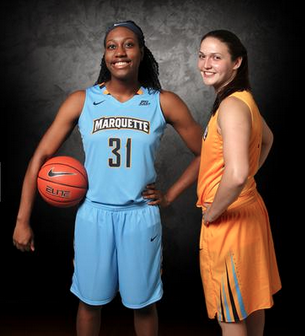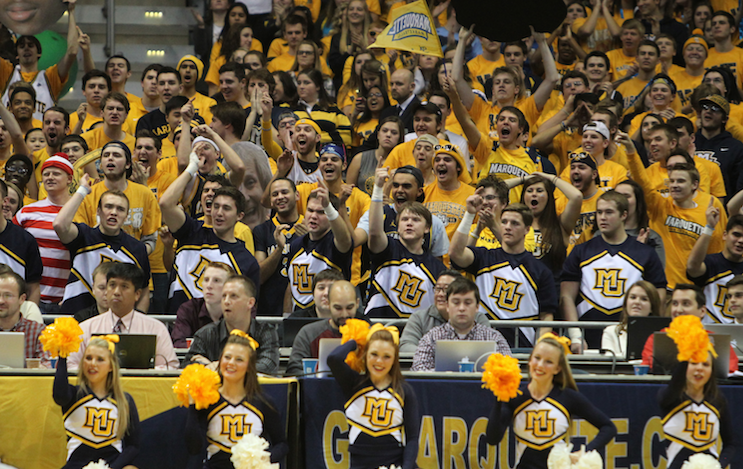Even with a National Marquette Day attendance of more than 19,000, floor projections for a new arena and a potential NBA lottery pick on the team, the university couldn’t stop the second straight drop in men’s basketball attendance.
Average game attendance fell to 13,308 for the 2015-’16 season, a decrease of 349 fans from last season’s 13,657. The average attendance between the 2006-’07 season and the 2014-’15 season was more than 15,400.
“I think we came off a period of success that in the history of our program stands with the consistency we had in the ’70s. We played in arguably the best basketball league ever constructed at that time,” said deputy athletic director Mike Broeker. “Regardless of who was coaching our program in 2014-’15, we were rebuilding. With rebuilding comes a dip in attendance. A lot of times when you have the success we had, you pick up fans who maybe aren’t so closely tied to the program.”
Director of Athletics Bill Scholl said it’s possible the decrease comes from the team not making the NCAA Tournament in recent years.
“Clearly, the more successful your team is, the easier your ticket sales equation becomes,” Scholl said.
Deputy athletic director Brian Hardin said the attendance drop signifies the importance of student fans. Students made up more than half of the decreasing attendance. On average, students accounted for 289 of the 349 fans lost per game on average, for an eight percent drop. Hardin said in no way does he blame the students for not coming to the games, and that it is his job to create an environment where students want to attend.
“We need to do a better job of making the game enticing enough for our students to purchase tickets and come to the game,” Hardin said. “Students bring the energy and enthusiasm to an arena. The more that are there, the louder and more fun the environment is.”
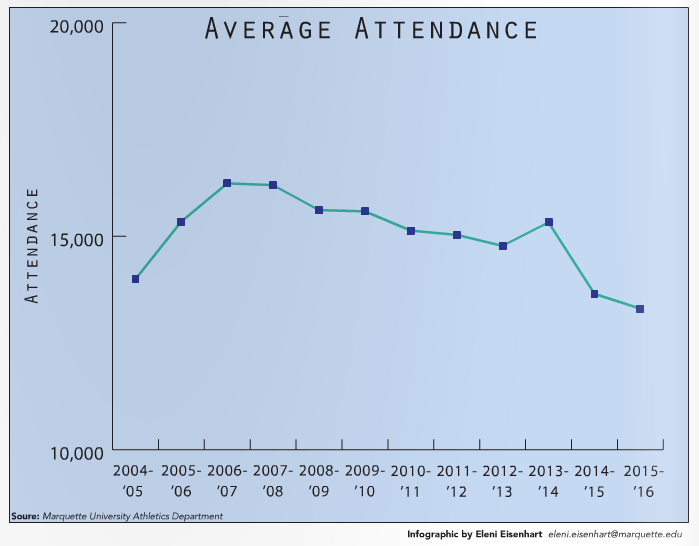 Despite the drop, group and single-game purchases were up 3,177, or 18 percent, this year. With a minor decrease in student attendance, it would indicate a more significant loss of season ticket holders.
Despite the drop, group and single-game purchases were up 3,177, or 18 percent, this year. With a minor decrease in student attendance, it would indicate a more significant loss of season ticket holders.
Marquette ranked second in attendance in the BIG EAST behind Creighton. It also ranked 21st in the nation in attendance, marking the 15th straight year landing in the top 25. However, the Golden Eagles play all of their home games at the 12th-largest venue in the NCAA – the BMO Harris Bradley Center – and have a capacity of 18,850. That means the team can easily exceed a team like Duke, which sells out nearly every game but has an arena capacity of just 9,300 fans.
Athletic department officials said the attendance drop also means a “slight revenue drop,” but not enough to make any serious impact.
Because the athletic department budgets conservatively, Broeker said a drop in revenue will not impact any of the other non-revenue generating sports at Marquette. He said they balance the budget so that the deficit can be made up through conference distribution, bonus incentives, philanthropy and corporate sponsorships.
“When it’s all said and done at the end of this fiscal year, we think revenue will be exactly where we predicted it to be,” Broeker said.
In the 12 years Broeker has been with the university, he said there has never been a situation in which another sport has been affected by a decline in revenue.
“Everybody understands the importance of the revenue men’s basketball drives to support our other programs, but we don’t budget or plan in a way where there would be a hole if a swing were to occur,” Broeker said.
He said a significant revenue drop could theoretically impact the budget for the subsequent year. Scholl declined to comment about the possibility of cutting budgets in other sports because of a revenue drop.
The average attendance is not the only thing on the downslope. The Wall Street Journal reported the overall value of the men’s basketball team decreased more than $11 million from last season, from about $71 million to $60 million. The team dropped from 28th to 35th in the overall value rankings. Forbes valued Marquette basketball at $11.4 million and ranked them 20th among all Division I programs. In 2015, Forbes had Marquette ranked 15th and valued at $12.2 million.
Broeker called the valuation rankings “junk science” and that it was nothing more than a timely interest piece around the NCAA tournament. Scholl also said he doesn’t put a lot of stock into those numbers. He said there is no lessened value to Marquette athletics.
“It doesn’t mean a lot in real terms. It’s not like we are going to be selling our basketball program any time soon,” Broeker said.
To Hardin, the value rankings provide a positive. He cited that Marquette is in the top 10 percent of all Division I college basketball teams and is the highest ranked team from a value standpoint that plays in an NBA arena.
Hardin said the athletic department took new steps this year to boost attendance numbers. These included the phone light app used for the Villanova and Georgetown games and the floor projections incorporated into the player introductions — a feature only used at Marquette.
In an effort to sell more tickets, Hardin helped create a section in the Bradley Center for recent graduates. In October, the department created the Coors Light Corner where recent graduates can buy season tickets and receive a free T-shirt, glass and voucher for a free beer at every game. Athletics had 316 season ticket holders in its debut season, which exceeded the 200-person goal.
“We want to get people in the arena earlier and make it more of an event,” Hardin said. “Let’s focus on what we can control. Coach (Steve Wojciechowski) and the guys will have a great year next year, and if we put the pieces in place … then the Bradley Center should be rocking.”
Broeker said he is “bullish” about the direction the program is headed. He said he thinks the attendance numbers will rebound to where they were several years ago. Much of his optimism lies with the emerging strength of the BIG EAST. He said the league has eight teams projected in KenPom’s top 55. He called the conference one of the best in the country, saying it doesn’t hurt to have a national champion in the conference with Villanova.
“Our league doesn’t take second fiddle to any league,” Broeker said. “As we continue to grow and have success, our revenue will grow alongside it.”
In future years, Scholl expects an attendance hike once the new arena is built. He said the Bradley Center was designed for hockey, so most of the best seats are up high — a design that does not suit basketball. The new arena is being designed for basketball games, with better seating in the lower sections nearer to the court.
“The way it’s being designed, from the information we received thus far, there are going to be lots more opportunities in the high-end amenities sorts of ways to hopefully monetize the seating in the new building at a more efficient rate than in the Bradley Center,” Scholl said.

